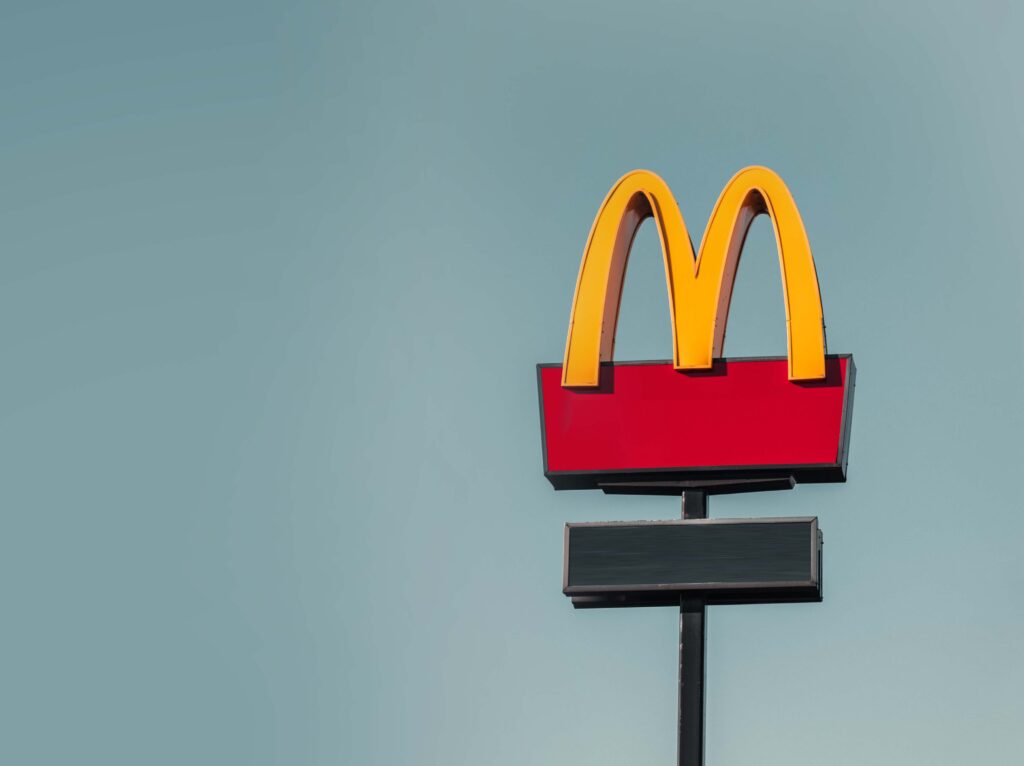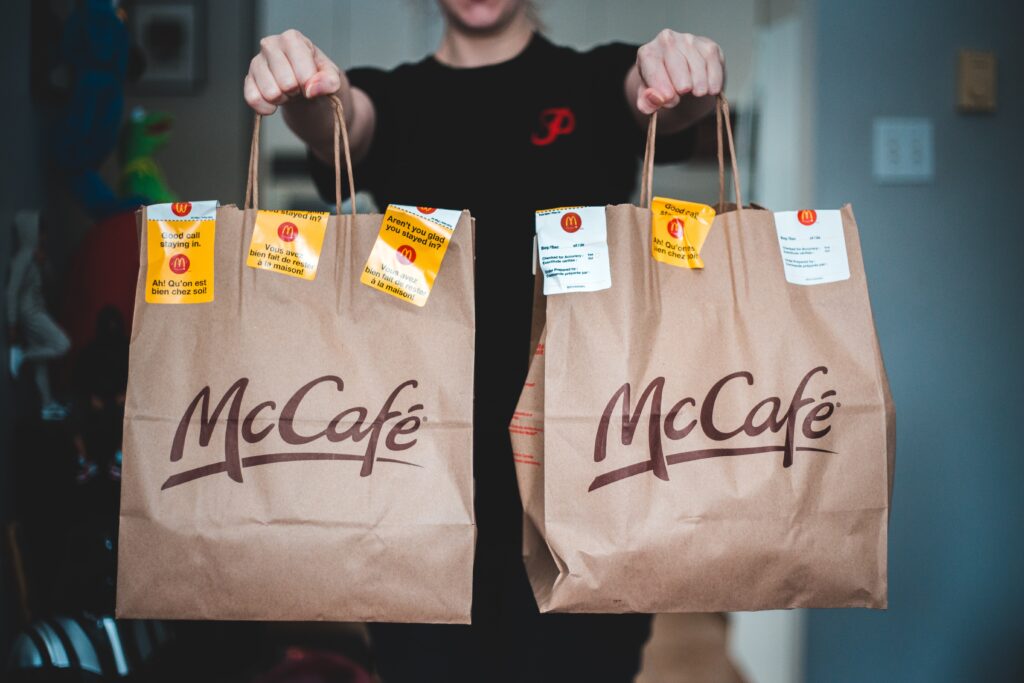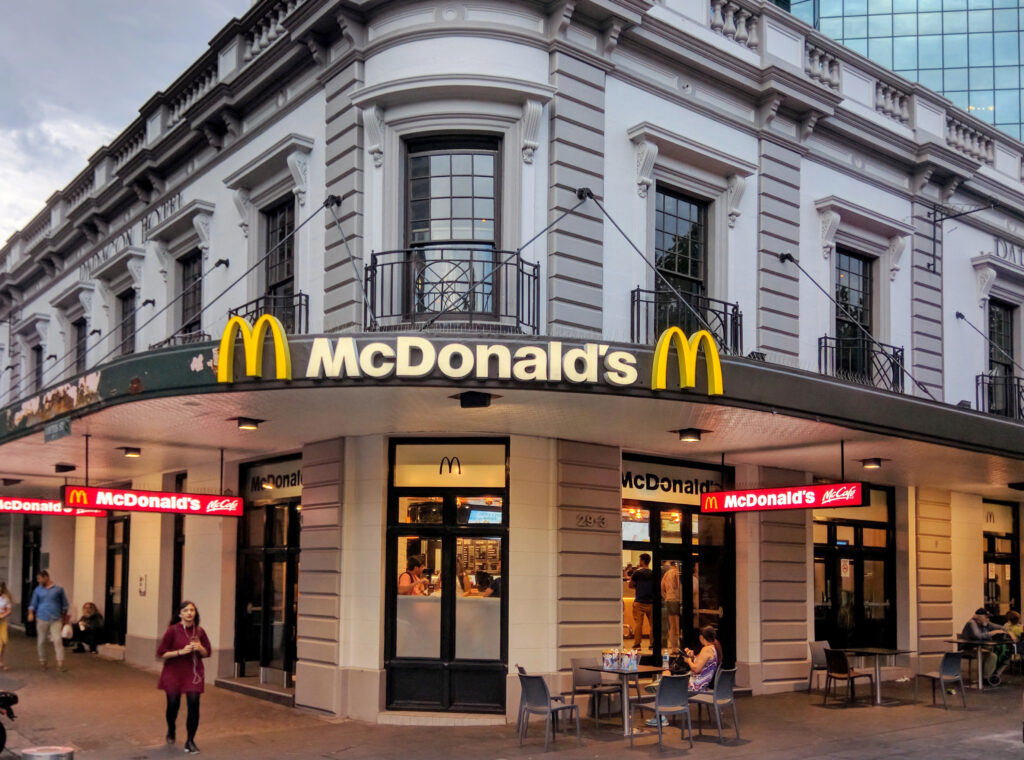Brand Strategy That is Still “McRelevant” Today
More so than the Big Mac, the Egg McMuffin, or those famous fries you just can’t keep your hands off, the most iconic part of the McDonald’s franchise and brand strategy as a whole is the “Golden Arches.” Sure, their signature selections such as those above, Chicken McNuggets, the Filet-o-Fish, or even those delicious McDonald’s hot apple pies are known and loved by millions across the globe. However, every company and brand strategy must start somewhere, even one that today that boasting over 3,600 individual restaurant locations with a strong, visible, successful presence in over 100 countries worldwide.
Table of Contents
- Introduction
- Refining and Defining a Brand Strategy
- Two Golden Icons are Born
- Brand Strategy for a New Look: “Speedee” Comes, and “Speedee” Goes
- For Those About toKroc
- Visualizing a Successful Brand Strategy: Look for the Arches
- Billions and Billions Served and Earned
- What’s a McNugget?
So, hit the “drive-thru” quickly, grab a Quarter Pounder with Cheese or a McChicken sandwich and ice-cold Coke, and don’t forget the fries. Then, settle in and take a “McJourney” with us back in time as we see how a food stand opened in a rural California community in 1937 and would eventually re-brand itself. Once they did, they were on the “McRoad” to becoming the most recognizable and iconic company, not only in the restaurant business but in any business across the entire world.
Refining and Defining a Brand Strategy
McDonald’s rose to worldwide prominence, starting with a humble beginning in a moderately sized town, Monrovia, California, in 1937. It was then that this franchise would lay the foundation for its brand strategy. Not too long after implementation, they could boast of their “billions and billions served” on their signs out front of each location. However, that brand strategy started as a food stand located near the Monrovia airport. The stand upon its opening, by Patrick McDonald, was called “The Airdome.” Initially, the biggest seller was hot dogs. However, as the stand saw modest business success, the menu would grow to include hamburgers, which cost ten cents apiece, and “all-you-can-drink” orange juice for just a nickel.
Fast forward to 1940, and Patrick’s two sons, Maurice, and Richard would take over the reins of “The Airdome.” The first step in their brand strategy is to bring the stand indoors and relocate it up the road about 40 miles to San Bernardino. The duo also renamed the restaurant at this point to “McDonald’s Bar-B-Que,” with a menu of some 25 items, most of which fell under the BBQ category.
However, by October 1948, the McDonald’s brothers realized that most of their profits came from the sale of hamburgers, so they briefly shut down their “drive-in” type restaurant, despite enjoying some success, to streamline the menu for a re-opening. Once ready for the relaunch, the word “Bar-B-Que” would be dropped, and from here forth, the restaurant was known as McDonald’s, and with a new, more convenient set up for preparation and service, they would re-open on December 12, 1948.

Two “Golden Icons” are Born
Moving right along in our “McHistory lesson” on brand strategy. Now, as McDonald’s enjoyed more and more success, by April of 1952, it was decided that a new look and a new building would be the next step in the evolution of the McDonald’s brand strategy. At this point, the company’s streamlined original menu had changed slightly, as it first included hamburgers, cheeseburgers, potato chips, soft drinks, and apple pie.
This switch would be significant because it would see the addition of milkshakes, which have remained a staple of the restaurant’s menu ever since. Likewise, and even more so than the shakes, this would also be when chips were removed in favor of the now famous McDonald’s French fries. There are two primary parts of the brand strategy that led to the brother’s combination feeling that the new building would help them accomplish. These parts were to make the service and all-around dining experience more efficient and present a more “eye-catching” look to the restaurant.
Upon construction of the new McDonald’s building, it was apparent that they had achieved the distinctive new look they set out for in their brand strategy. The new eye-pleasing features included surfaces of shiny, red, and white ceramic tile, stainless steel, brightly colored sheet metal, and glass. In addition, pulsating white, green, red, and yellow neon throughout the restaurant were new and bold additions to the décor.
However, the one significant aesthetic addition that no one could have ever imagined would become a symbol recognized across six continents at the time. This addition was two 25-foot yellow sheet metal arches, at the time trimmed in neon. Even in the design stage, these were referred to in a term we all would come to know, the “Golden Arches.”
Brand Strategy for a New Look: “Speedee” Comes, and “Speedee” Goes

The improved efficiency, along with the desire to become more visible, had become the two-pronged brand strategy aimed at the expansion and was a significant step in building the “new” McDonald’s brand. Regarding the “new look,” at first, the now-iconic arches were not necessarily seen yet as the company’s primary logo. The first new symbol moving forward was to stress the new, faster, and more efficient “Speedee Service System.” This would be a “pudgy character” wearing a chef’s hat, whose face somewhat resembled a hamburger named Speedee. The winking eye of Speedie was said to have been a tip of the cap and represent the faster service than their food facility. However, though the cartoonish “Speedie” was the original logo, so to speak, the McDonald’s brothers had initially thought of the “arches” as to catch the attention of bypassers. Hmmm…maybe, just maybe, they were onto something.
As with any strong brand strategy, there are points where the company’s that succeed realize they must evolve or change for the better. In the case of McDonald’s, this change would fully take place when in 1961, Ray Kroc purchased the business from Maurice and Richard. Once Kroc was the owner, he again called for modifications to the brand identity. These would be ones that would change the restaurant industry and ones that would reach every corner of the Earth.
That’s Kroc with a ‘k’ Like ‘crocodile’ but not spelled that way (As Mr. Knofler puts it in his tribute song to Ray Kroc; “Boom, Like That”)
The brothers feared that making risking a national venture could change their thriving local business. Thus, Kroc would offer to help more with brand strategy and take on a significant portion of the responsibility in this expansion. When leaving his discussions with the McDonald’s boys, he had headed home to just outside of Chicago is given the rights to set up McDonald’s franchises all across the United States.
The initial relationship between Ray Kroc and the McDonald’s began in 1954 when he had visited them upon hearing they used eight Prince Castle brand milkshake machines, which were the same brand he was selling. When Kroc showed up at the San Bernardino location, McDonald’s restaurants had grown to include six franchises. Believing that this restaurant model had limitless potential, Kroc suggested that they franchise all over the country as part of his brand strategy.
The first McDonald’s that Kroc would open was near his home in De Plains, IL, in 1955. He would call on a professional, a master painter, Eugene Wright. Kroc asked this expert on color schemes and came up with an idea for his restaurants. Wright would return with the white and yellow with a dark brown and red trim color pattern that has pretty much been synonymous with McDonald’s ever since. Once his Des Plains location was opened, Kroc began looking for franchisees.
Getting business advice and assistance with the brand strategy from the former VP of finance for the Tastee Freeze company, Harry Sonneborn, by 1958, the total of McDonald’s restaurants would grow to 34 in the U.S. Just a year later, Kroc enlisted Sonneborn as President and CEO of McDonald’s. In that year alone, 68 new franchises opened across the country, bringing the total to 102 locations.
Visualizing a Successful Brand Strategy: Look for the Arches
In 1960, the company’s brand strategy called for a new advertising campaign. This campaign for McDonald’s would be implemented and, although not known at the time, would be the most crucial change in establishing their brand in company history. This would be the most significant part of the McDonald’s brand strategy ever, as they unveiled a new slogan. It was “Look for the Golden Arches.” There was an immediate boost in sales as this campaign went public, and in 1962, “Speedie” would be no more, and the arches seen outside the restaurants would take the form of a letter “M,” and the golden arches logo was born.
As the early 1960s moved along, the arches would be the launching pad to see the McDonald’s rocket to new heights. The timing would coincide with the national growth of the automobile and the addition of the interstate highway system. However, all was not well between Kroc and the two McDonald’s brothers despite the success. This was due to a stark contrast in the company’s two sides’ brand strategy and vision. The difference of opinion eventually became unbearable, leading to Kroc offering to buy out the brother partners.
The brothers would take $2.7 million ($21.6 in today’s dollars), and Kroc bought them out. Following this in 1965, the company went public, and in doing so, their basing the new brand strategy on listening to what the customer wanted would pay huge dividends. This saw several staples of their menu to this very day introduced throughout a several-year period. These would include “Filet O Fish” (1962) and the now legendary Big Mac in 1968. That would also be the year Sonneborn stepped down, and Kroc himself took over as President and SEO.
With the nation now “driving-thru” and “looking for the arches,” Kroc again evolved his brand strategy with the time’s coming up with one of the most well-known marketing campaigns in the history of any business, as the golden arches would accompany a new slogan, “You deserve a break today.” Shortly after that campaign launched, the expansion of McDonald’s found the restaurant opening its 1,000th location and finally being present in all 50 United States.

Billions and Billions Served…and Earned
The decade of the 1970s would bring more fresh brand strategy ideas. Thus came even bigger and better things for McDonald’s. In 1972, the company would, for the first time, pass $1 billion in annual sales. By mid-decade, in 1976, that total would go over $3 billion, and as the signs in front of each location would tout, they had served upwards of 20 billion hamburgers. Also, during this stretch, breakfast became part of the brand strategy. Then another legendary sandwich and fast-food innovation were developed. The Egg McMuffin came in 1972, and the expanded world of fast-food breakfast was not far behind.
In 1977 McDonald’s would create a full breakfast menu, and in ten years, by 1987, 25 percent of all breakfast eaten out in America was eaten at a McDonald’s. Also, the drive-thru window was added at locations in 1975, and in 1979 yet another iconic part of the McDonald’s brand was introduced, and children nationwide began asking their parents for a “Happy Meal.”
Sure, all of these new marketing ideas would be a massive part of the McDonald’s brand strategy moving forward. But the menu would not be all that would see changes that would come to help define this brand. So in the early part of the decade, Kroc, just as he had for the color scheme, called on an expert in helping to come up with a new look for the restaurants.
What was then developed was the iconic four-sided, natural brick and cedar mansard roofs that practically everyone in the world is now familiar with. Maybe the most prominent brand strategy development of the 70s, though, was the beginning of McDonald’s global expansion. Countries around the globe around mid-decade would, for the first time, see the golden arches as they would eventually become one of the most recognizable brand logos ever created. Yet, somehow, this was all still just the beginning of the growth of the McDonald’s brand
As with any successful brand strategy, the constant we have seen in McDonald’s growth the ability to change with the times and keep their finger on the pulse of what the public and the customer want to see. So, keeping course with its brand strategy to unveil new products that would become world-famous, with the start of the 1980s came the debut of Chicken McNuggets.
What’s a McNugget?
While it spurned many late-night talk jokes from the name, their popularity was off the charts, and they remain a top seller today. Heading forward and continuing to evolve with the times as they have since Kroc to over the reins of the franchise, McDonald’s in the 1990s would introduce another soon-to-be favorite, the ice cream McFlurry.
But the brand strategy not just about food items, changes in design to their restaurants, or just the worldwide expansion that kept pushing the McDonald’s brand above and beyond the competition. The creative genius behind the brand strategy and marketing would again unveil a strategy for a campaign that would again strike gold starting in 2003 behind the slogan, “I’m Lovin’ it.” It is the continuous ability to stay on top of the pulse of the public that genuinely pushed them to the point of becoming more than just a chain of fast-food restaurants and becoming a part of pop culture and a worldwide entity.

Behind all of that, from almost the beginning, has been the iconic yellow arches that if you drive down about any highway in American or in the world for that matter, you can see sticking out above the competitors from a distance. Seeing the arches high above the landscape not only gives you an early start at deciding where to eat on a road trip, but it also serves as a symbol. A symbol that was initially developed in the early 1960s but has continued to climb higher and higher above the proverbial “other rooftops” with no end to that perpetual ascent in sight.
(cover photo by: Photo by Bryan Hong of The oldest operating McDonald’s restaurant was the third one built, opening in 1953. It’s located at 10207 Lakewood Blvd. at Florence Ave. in Downey, California.